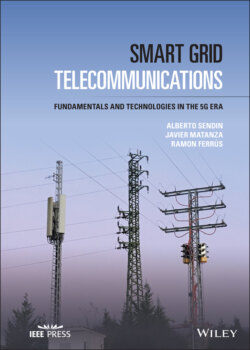Читать книгу Smart Grid Telecommunications - Ramon Ferrús - Страница 38
1.5.2 Grid Control Challenges
ОглавлениеWithin the Transmission segment, challenges are those inherent to its role in the system. Despite the evolution of the electric power system technologies, Transmission has not been affected by technical disruptions that impose a new reinvention of its nature. However, their traditional functions can be pretty much enhanced.
The need to keep energy loss at a minimum justifies the need to understand and control the different power line parameters involved in ampacity (i.e., maximum value of electric current – Amperes) calculations. Grid stability is another concept of great importance, as the connection of bulk‐generation at different parts of the network can cause instability if the voltage phase difference between the power signals is too different at the two ends of the line. Last but not least, harmonics of the fundamental frequency (50 or 60 Hz) have to be controlled, as they would be propagated along the grid, impacting overall quality of the electricity wave.
There are other needs related with the physical aspects of the cables, leading to keep the infrastructure available and extending its useful life [41]. There is a growing need to easily detect the origin of faults in the power lines and be able to identify and communicate its exact location. These needs can be supported with modern telecommunications‐related technology. These technologies can also help to control strain in the cables when they are being laid out, specifically in cables under special conditions (e.g., submarine routes).
Distribution grid challenges are the ones that have been driving the evolution of the Smart Grid concept in the network control side. The paradigm of a static unidirectional network delivering electricity from the core to the edge has changed into an entangled mix of new technologies and assets, with varied properties, that needs to be organized. The new idea of a “platform” [42], rather than a “grid” that can serve the different Distribution grid stakeholders, has become popular due to its use in some major initiatives.
Automation tries to drive the grid toward becoming a self‐healing entity. Automation in utilities consists of Substation Automation (SA) and Distribution Automation (DA). Automation process started at substation level, mainly PSs (hence SA), and moved out toward the edge (hence DA), increasing its ambition to reach every corner of the grid with that kind of automatic signals driving electricity through the most appropriate routes (like information is routed in telecommunications networks, differences aside). The aid of ICTs and telecommunications in grid automation is highlighted in [43] with the term ADA (Advanced Distribution Automation). The ultimate objective of the self‐healing grid is to improve the service availability introducing efficiencies in the grid operation (less manual and field interventions).
The appearance of DER alters the traditional equilibrium of things in the Distribution grid. E.g., DG and EVs come with some caveats that change the landscape of traditional grid operation. On the more general side, operational procedures need to be modified as they can no longer assume that energy flow is not unidirectional (restoration manoeuvers may need power to be completely for the safety of people and assets). On the other, a greater visibility and control of the elements of the grid, including those of the new technologies close or in the Consumption Points, to enable the operational procedures.
Now the Smart Grid in the Distribution segment needs to be seen as the superposition of the grid with the new grid technologies, and a telecommunications network providing connectivity to any corner of the grid to measure, control, and remotely operate the different IEDs (Intelligent Electronic Devices) attached to the grid assets [35]. A different proportion of central and distributed intelligence will use this connectivity to run algorithms able to make autonomous decisions and perform sophisticated actions that will be monitored from UCCs.
